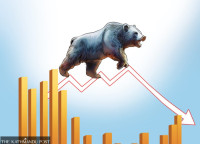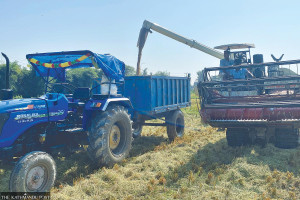Money
ADB lowers economic growth forecast to 4.7pc
After the World Bank, another multilateral lender, the Asian Development Bank (ADB), has also revised Nepal’s economic growth forecast downwards for the current fiscal year.
After the World Bank, another multilateral lender, the Asian Development Bank (ADB), has also revised Nepal’s economic growth forecast downwards for the current fiscal year.
The Manila-based multilateral lender estimates Nepal’s economy to grow at a slower rate of 4.7 percent in the fiscal year 2017-18 in the wake of landslides and floods that are likely to depress farm output. This growth estimate is lower than previous forecast of 5.4 percent for 2017-18.
Earlier, the World Bank had also revised its growth estimate to 4.6 percent for the current fiscal year from 5 percent, stating floods will hit agricultural output.
The forecasts made by the two multilateral lenders are way lower that the government’s growth estimate of 7.2 percent for the current fiscal year. Nepal’s economy had expanded by 23-year high of 6.9 percent in the last fiscal year.
“The economy rebounded strongly in 2016-17 from 2015-16, a difficult year with external shocks. This year we expect economic growth to revert somewhat to the trend growth rate, partly because of floods,” said Sharad Bhandari, principal economist and officer-in-charge of ADB’s Nepal Resident Mission.
Agriculture output is expected to expand by mere 2.4 percent in 2017-18 from 5.3 percent in 2016-17, as floods inundated paddy fields and destroyed crops in most of the Tarai districts, says the latest Macroeconomic Update of the ADB. This, according to the ADB, will depress farm output, which makes a contribution of around 30 percent to the gross domestic product.
Depressed farm output and damage caused to infrastructure by the recent floods are also expected to raise consumer prices.
Preliminary estimate shows that agriculture production worth of Rs8.1 billion, livestock worth Rs10.1 billion and irrigation infrastructure worth Rs15.5 billion were destroyed by floods and landslides. Additionally, infrastructure damage from the recent flooding has obstructed smooth flow of goods within and outside the country. This will likely trigger short-supply and deficits, intensifying consumer price pressure in 2017-18.
These factors may prompt inflation to stand at 6.5 percent in the current fiscal year, up from 4.5 percent in 2016-17, according to the ADB. The inflation forecast for 2017-18 is partly based on expectations of higher domestic demand, notably from reconstruction, election-related spending and higher government expenditures under the new federal structure, says the report.
“The proposed expansionary budget for the current fiscal year, including fiscal transfer, could raise inflationary pressure,” adds the report.
In spite of introduction of a fat budget, national pride projects have continued to face implementation delays in 2017-18. This will likely lead to a substantial shortfall in capital expenditure and depress economic growth, says the report.
Also, though dates for provincial and federal level elections have been announced, several bills, namely, Natural Resources and Fiscal Commission including Inter-governmental Fiscal Transfer, which are imperative for effective implementation of fiscal federalism, are yet to be enacted. In absence of these bills, distribution of natural resources and revenue among all three tiers of government will be affected, hampering growth prospect in 2017-18, says the report.
However, the industry sector, buoyed by increased supply of electricity and availability of construction materials, will likely expand by 6.6 percent in the current fiscal year, albeit down from a growth of 10.9 percent in the last fiscal year, the ADB predicts.
Additionally, the enactment of Labour and Special Economic Zone (SEZ) bills are expected to improve investor sentiment, favouring manufacturing output. Services sector is forecast to grow by 5.5 percent in the current fiscal year owing largely to likely expansion of wholesale and retail trade, financial intermediation and travel and tourism sub-sectors, according to the ADB.




 18.12°C Kathmandu
18.12°C Kathmandu














